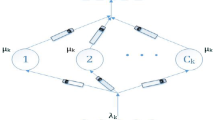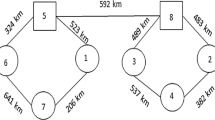Abstract
Hub locations are NP-hard problems used in transportation systems. In this paper, we focus on a single-allocation hub covering location problem considering a queue model in which the number of servers is a decision variable. We propose a model enhanced with a queue estimation component to determine the number and location of hubs and the number of servers in each hub, and to allocate non-hub to hub nodes according to network costs, including fixed costs for establishing each hub and server, transportation costs, and waiting costs. Moreover, we consider the capacity for a queuing system in any hub node. In addition, we present a metaheuristic algorithm based on particle swarm optimization as a solution method. To evaluate the quality of the results obtained by the proposed algorithm, we establish a tight lower bound for the proposed model. Genetic programming is used for lower bound calculation in the proposed method. The results showed better performance of the proposed lower bound compared to a lower bound obtained by a relaxed model. Finally, the computational results confirm that the proposed solution algorithm performs well in optimizing the model with a minimum gap from the calculated lower bound.












Similar content being viewed by others
References
Adler N, Smilowitz K (2007) Hub-and-spoke network alliances and mergers: price-location competition in the airline industry. Trans Res Part B Methodol 41:394–409
Alumur SA, Kara BY, Karasan OE (2009) The design of single allocation incomplete hub networks. Trans Res Part B Methodol 43:936–951. doi:10.1016/j.trb.2009.04.004
Alumur SA, Nickel S, Saldanha-da-Gama F (2012) Hub location under uncertainty. Trans Res Part B Methodol 46:529–543. doi:10.1016/j.trb.2011.11.006
Amiri M, Eftekhari M, Dehestani M, Tajaddini A (2013) Modeling intermolecular potential of He–\(\text{F}_{2}\) dimer from symmetry-adapted perturbation theory using multi-gene genetic programming. Scientia Iranica 20(3):543–548
Bashiri M, Mirzaei M, Randall M (2013) Modeling fuzzy capacitated p-hub center problem and a genetic algorithm solution. Appl Math Model 37:3513–3525. doi:10.1016/j.apm.2012.07.018
Berman O, Wang J (2011) The minmax regret gradual covering location problem on a network with incomplete information of demand weights. Eur J Oper Res 208:233–238
Campbell JF (1994) Integer programming formulations of discrete hub location problems. Eur J Oper Res 72:387–405
Campbell JF (2013) A continuous approximation model for time definite many-to-many transportation. Trans Res Part B Methodol 54:100–112. doi:10.1016/j.trb.2013.04.002
Chen J-S, Chang C-L, Hou J-L, Lin Y-T (2008) Dynamic proportion portfolio insurance using genetic programming with principal component analysis. Expert Syst Appl 35:273–278
Cunha CB, Silva MR (2007) A genetic algorithm for the problem of configuring a hub-and-spoke network for a LTL trucking company in Brazil. Eur J Oper Res 179:747–758
Davari S, Zarandi MF, Turksen IB (2013) The incomplete hub-covering location problem considering imprecise location of demands. Scientia Iranica 20(3):983–991
de Camargo RS, Miranda G Jr, Ferreira RPM, Luna H (2009) Multiple allocation hub-and-spoke network design under hub congestion. Comput Oper Res 36:3097–3106
de Sá EM, de Camargo RS, de Miranda G (2013) An improved Benders decomposition algorithm for the tree of hubs location problem. Eur J Oper Res 226:185–202. doi:10.1016/j.ejor.2012.10.051
Elhedhli S, Hu FX (2005) Hub-and-spoke network design with congestion. Comput Oper Res 32:1615–1632
Farahani RZ, Hekmatfar M, Arabani AB, Nikbakhsh E (2013) Hub location problems: a review of models, classification, solution techniques, and applications. Comput Ind Eng 64(4):1096–1109
Garg A, Sriram S, Tai K (2013) Empirical analysis of model selection criteria for genetic programming in modeling of time series system. In: Proceedings of 2013 IEEE Conference on Computational Intelligence for Financial Engineering and Economics (CIFEr), Singapore, pp. 84-88
Garg A, Tai K (2013) Selection of a robust experimental design for the effective modeling of the nonlinear systems using genetic programming. In: Proceedings of 2013 IEEE Symposium on Computational Intelligence and Data mining (CIDM), Singapore, pp. 293–298
Hamidi M, Gholamian M, Shahanaghi K (2014) Developing prevention reliability in hub location models. In: Proceedings of the Institution of Mechanical Engineers, Part O: Journal of Risk and Reliability:1748006X13519247
Kara B, Tansel B (2003) The single-assignment hub covering problem: models and linearizations. J Oper Res Soc 54:59–64
Karimi H, Bashiri M (2011) Hub covering location problems with different coverage types. Scientia Iranica 18:1571–1578
Koza JR (1990) Concept formation and decision tree induction using the genetic programming paradigm. In: International Conference on parallel problem solving from nature. Springer, Berlin, pp 124–128
Lin MH (2013) Airport privatization in congested hub-spoke networks. Trans Res Part B Methodol 54:51–67. doi:10.1016/j.trb.2013.03.011
Marianov V, Serra D (2003) Location models for airline hubs behaving as M/D/c queues. Comput Oper Res 30:983–1003
Meyer T, Ernst AT, Krishnamoorthy M (2009) A 2-phase algorithm for solving the single allocation p-hub center problem. Comput Oper Res 36:3143–3151. doi:10.1016/j.cor.2008.07.011
Mohammadi M, Tavakkoli-Moghaddam R, Tolouei H, Yousefi M (2010) Solving a hub covering location problem under capacity constraints by a hybrid algorithm. J Appl Oper Res 2:109–116
Mohammadi M, Jolai F, Rostami H (2011) An M/M/c queue model for hub covering location problem. Math Comput Model 54:2623–2638
Mohammadi M, Jolai F, Tavakkoli-Moghaddam R (2013) Solving a new stochastic multi-mode p-hub covering location problem considering risk by a novel multi-objective algorithm. Appl Math Model 37(24):10053–10073
Mohammadi M, Torabi S, Tavakkoli-Moghaddam R (2014) Sustainable hub location under mixed uncertainty. Trans Res Part E Logist Trans Rev 62:89–115
O’kelly ME (1986) The location of interacting hub facilities. Trans Sci 20:92–106
Parvaresh F, Husseini SM, Golpayegany SH, Karimi B (2014) Hub network design problem in the presence of disruptions. J Intell Manuf 25(4):755–774
Puerto J, Ramos AB, Rodríguez-Chía AM (2011) Single-allocation ordered median hub location problems. Comput Oper Res 38:559–570. doi:10.1016/j.cor.2010.07.018
Randall M (2008) Solution approaches for the capacitated single allocation hub location problem using ant colony optimisation. Comput Optim Appl 39:239–261
Rodriguez V, Alvarez M, Barcos L (2007) Hub location under capacity constraints. Trans Res Part E Logist Trans Rev 43:495–505
Saaty TL (1961) Elements of queueing theory: with applications. McGraw-Hill, New York
Sasaki M, Campbell JF, Krishnamoorthy M, Ernst AT (2014) A Stackelberg hub arc location model for a competitive environment. Comput Oper Res 47:27–41
Setak M, Karimi H (2014) Hub covering location problem under gradual decay function. J Sci Ind Res 73:145–148
Wagner B (2007) Model formulations for hub covering problems. J Oper Res Soc 59:932–938
Walker M (2001) Introduction to genetic programming. Tech Np: University of Montana, Missoula
Zarandi MF, Davari S, Sisakht SH (2012) The Q-coverage multiple allocation hub covering problem with mandatory dispersion. Scientia Iranica 19(3):902–911
Zhai H, Liu Y, Chen W (2012) Applying minimum-risk criterion to stochastic hub location problems. Procedia Eng. 29:2313–2321
Author information
Authors and Affiliations
Corresponding author
Ethics declarations
Conflict of interest
The authors declare that they have no conflict of interest.
Additional information
Communicated by V. Loia.
Rights and permissions
About this article
Cite this article
Hasanzadeh, H., Bashiri, M. & Amiri, A. A new approach to optimize a hub covering location problem with a queue estimation component using genetic programming. Soft Comput 22, 949–961 (2018). https://doi.org/10.1007/s00500-016-2398-1
Published:
Issue Date:
DOI: https://doi.org/10.1007/s00500-016-2398-1




